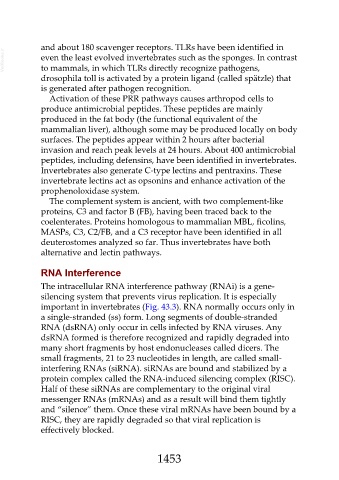Page 1453 - Veterinary Immunology, 10th Edition
P. 1453
and about 180 scavenger receptors. TLRs have been identified in
VetBooks.ir even the least evolved invertebrates such as the sponges. In contrast
to mammals, in which TLRs directly recognize pathogens,
drosophila toll is activated by a protein ligand (called spätzle) that
is generated after pathogen recognition.
Activation of these PRR pathways causes arthropod cells to
produce antimicrobial peptides. These peptides are mainly
produced in the fat body (the functional equivalent of the
mammalian liver), although some may be produced locally on body
surfaces. The peptides appear within 2 hours after bacterial
invasion and reach peak levels at 24 hours. About 400 antimicrobial
peptides, including defensins, have been identified in invertebrates.
Invertebrates also generate C-type lectins and pentraxins. These
invertebrate lectins act as opsonins and enhance activation of the
prophenoloxidase system.
The complement system is ancient, with two complement-like
proteins, C3 and factor B (FB), having been traced back to the
coelenterates. Proteins homologous to mammalian MBL, ficolins,
MASPs, C3, C2/FB, and a C3 receptor have been identified in all
deuterostomes analyzed so far. Thus invertebrates have both
alternative and lectin pathways.
RNA Interference
The intracellular RNA interference pathway (RNAi) is a gene-
silencing system that prevents virus replication. It is especially
important in invertebrates (Fig. 43.3). RNA normally occurs only in
a single-stranded (ss) form. Long segments of double-stranded
RNA (dsRNA) only occur in cells infected by RNA viruses. Any
dsRNA formed is therefore recognized and rapidly degraded into
many short fragments by host endonucleases called dicers. The
small fragments, 21 to 23 nucleotides in length, are called small-
interfering RNAs (siRNA). siRNAs are bound and stabilized by a
protein complex called the RNA-induced silencing complex (RISC).
Half of these siRNAs are complementary to the original viral
messenger RNAs (mRNAs) and as a result will bind them tightly
and “silence” them. Once these viral mRNAs have been bound by a
RISC, they are rapidly degraded so that viral replication is
effectively blocked.
1453

